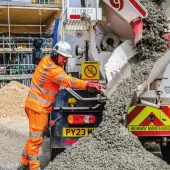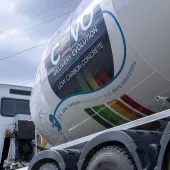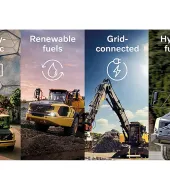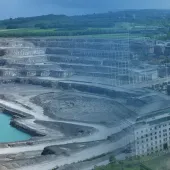Paving the way for net-zero roads
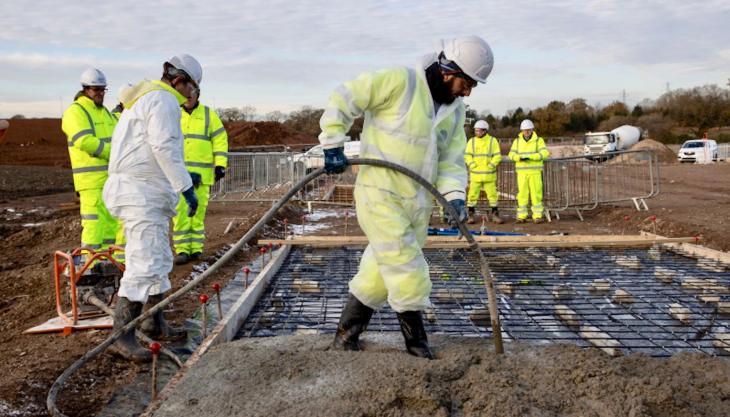
Tarmac involved in low-carbon concrete trial that is set to be extended to permanent roads
WORKING with Tarmac, the success of an industry-first Skanska UK and National Highways low-carbon concrete trial is to be extended to permanent roads.
Over the past year, Skanska, alongside the National Composites Centre, Tarmac, Basalt Technologies, and National Highways, has carried out a trial on a low-carbon reinforced concrete solution.
The results show that the solution has led to a reduction of more than 50% in carbon. It has also proven to be equally resilient as conventional reinforced concrete using steel. Skanska have now published a report on the trials conducted on their M42 junction 6 project for National Highways.
The trial has proven to be such a success that Skanska are now working collaboratively with National Highways and High Speed 2 Ltd (HS2) on the next phase. The plan is to trial the low-carbon combination on a permanent road and capture all the data and analysis for future publication. The ultimate aim is to roll out the low-carbon solution across the UK’s strategic road network.
Skanska are also working with HS2’s innovation managers to progress the insights from the trial and use the innovative combination of materials in other structural reinforced concrete elements beyond roads.
Skanska’s highways director, Glennan Blackmore, said: ‘The results of the trial are extremely encouraging. By working together, we have been able to speed up the process of testing and analysing a new solution for decarbonizing our road network, with the aim of getting it to market so the whole industry can benefit.
‘By using a unique combination of materials, we are working to not only cut carbon, but also improve the structural performance of reinforced concrete, delivering better productivity, safety, and cost outcomes. We’re delighted to see the success of this trial and we’re now really looking forward to starting the next stage.’
The trial also provides a better understanding of the impact of using the new materials – including the use of composites in the design of concrete structures – ahead of the proposed revision to Eurocode 2 standards.
Adam Gallis, National Highways project manager, said: ‘At National Highways, we were delighted to use our Innovation and Modernization Designated Fund Pot to help make this trial a reality. In utilizing this funding, we can go above and beyond what we would typically deliver on our schemes.
‘In this instance, working alongside the supply chain, we have made great strides in the development of a low-carbon reinforced-concrete alternative. We will look to do what we can to facilitate further trials in this sphere, to ultimately drive down our carbon footprint and achieve our net-zero targets.
Tarmac provided two types of concrete for the trial: a mix comprising conventional blended cementitious material and a low-carbon alternative mix incorporating an alkali activated cementitious material (AACM) in place of the cement. This sustainable low-carbon concrete solution was mixed at a conventional concrete plant located close to the project, installed in exactly the same way as traditional materials, and delivers up to 80% reduction in carbon footprint compared with a standard CEM I concrete.
The reinforcement steel replacement was a basalt fibre reinforced polymer rebar. This is five times lighter and twice as strong as its steel counterpart, and is naturally resistant to corrosion, alkalis, and acids. The main component of Bastech rebar is basalt fibre, which is manufactured directly from basalt – the most common rock on the Earth’s surface – in a single-melt process and comprises only a single raw material. On average, it delivers a 60% reduction in CO2 emissions compared with steel and provides a cost-effective substitute.
The trial involved the construction of four concrete slabs at the M42 junction 6 highways improvement scheme. The slabs were laid in December 2021, consisting of: Slab A – conventional concrete + steel reinforcement; Slab B – low-carbon concrete + steel reinforcement; Slab C – conventional concrete + basalt reinforcement; and Slab D – low-carbon concrete + basalt reinforcement.
The road was heavily used by construction vehicles throughout the trial period, with in-situ and laboratory tests carried out over a number of months. Full-scale specialist lab tests involved bending and shear testing of the four slab types.
The results have provided knowledge of the curing process, ease of construction, safety benefits, functional properties, and structural behaviour of the various concrete and reinforcement combinations. This has given insight into the future use of longer-lasting materials in construction.



